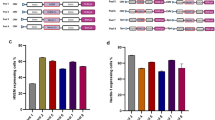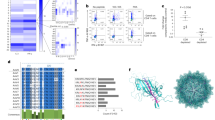Abstract
The development of genetically modified adenovirus (Ad) vectors with specificity for a single cell type will require both the introduction of novel tropism determinants and the ablation of endogenous tropism. Consequently, it will not be possible to exploit the native cellular entry pathway in the propagation of these targeted Ad vectors. Based on the concept that Ad enters cells by a two-step process in which a primary receptor serves as a high affinity binding site for the Ad fiber knob, with subsequent internalization mediated by αv integrins, we designed two artificial primary receptors. The extracellular domain of one of these synthetic receptors was derived from a single-chain antibody (sFv) with specificity for Ad5 knob, while the second receptor consisted of an icosapeptide identified by biopanning a phage display library against Ad5 knob. Expression of either of these artificial virus-binding receptors in fiber receptor-negative cells possessing αv integrins conferred susceptibility to Ad infection. We then created a novel mechanism for cell binding by genetically modifying both the vector and the target cell. In this approach, six histidine (His) residues were incorporated at the C-terminal of the Ad fiber protein. The resultant Ad vector was able to infect nonpermissive cells displaying the cognate artificial receptor, containing an anti-His sFv. This strategy, comprising a genetically engineered Ad virion and a modified cell line, should be useful in the propagation of targeted Ad vectors that lack the ability to bind the native fiber receptor.
This is a preview of subscription content, access via your institution
Access options
Subscribe to this journal
Receive 12 print issues and online access
$209.00 per year
only $17.42 per issue
Buy this article
- Purchase on Springer Link
- Instant access to full article PDF
Prices may be subject to local taxes which are calculated during checkout






Similar content being viewed by others
References
Zabner, J., Freimuth, P., Puga, A., Fabrega, A. & Walsh, M.J. Lack of high affinity fiber receptor activity explains the resistance of ciliated airway epithelia to adenovirus infection. J. Clin. Invest. 100, 1144–1149 (1997).
Pickles, R.J. et al. Limited entry of adenovirus vectors into well-differentiated airway epithelium is responsible for inefficient gene transfer. J. Virol. 72, 6014–6023 (1998).
Dmitriev, I. et al. An adenovirus vector with gentically modified fibers demonstrates expanded tropism via utilization of a coxsackievirus and adenovirus receptor-independent cell entry mechanism. J. Virol. 72, 9706 –9713 (1998).
Miller, C.R. et al. Differential susceptibility of primary and established human glioma cells to adenovirus infection: targeting via the epidermal growth factor receptor achieves fiber receptor-independent gene transfer. Cancer Res. 58, 5738–5748 (1998).
Bergelson, J.M. et al. Isolation of a common receptor for coxsackie B viruses and adenoviruses 2 and 5. Science 275, 1320– 1323 (1997).
Tomko, R.P., Xu, R. & Philipson, L. HCAR and MCAR: the human and mouse cellular receptors for subgroup C adenoviruses and group B coxsackieviruses. Proc. Natl. Acad. Sci.USA 94, 3352–3356 (1997).
Bergelson, J.M. et al. The murine CAR homolog is a receptor for coxsackie B viruses and adenoviruses. J. Virol. 71, 415– 419 (1998).
Hong, S.S., Karayan, L., Tournier, J., Curiel, D.T. & Boulanger, P.A. Adenovirus type 5 fiber knob binds to MHC class Ialpha2 domain at the surface of human epithelial and B lymphoblastoid cells. EMBO J. 16, 2294– 2306 (1997).
Henry, L.J., Xia, D., Wilke, M.E., Deisenhofer, J. & Gerard, R.D. Characterization of the knob domain of the adenovirus type 5 fiber protein expressed in Escherichia coli. J. Virol. 68, 5239–5246 (1994).
Louis, N., Fender, P., Barge, A., Kitts, P. & Chroboczek, J. Cell-binding domain of adenovirus serotype 2 fiber. J. Virol. 68, 4104–4106 (1994).
Bai, M., Harfe, B. & Freimuth, P. Mutations that alter an Arg-Gly-Asp (RGD) sequence in the adenovirus type 2 penton base protein abolish its cell-rounding activity and delay virus reproduction in flat cells. J. Virol. 67, 5198–5205 (1993).
Wickham, T.J., Mathias, P., Cheresh, D.A. & Nemerow, G.R. Integrins alpha v beta 3 and alpha v beta 5 promote adenovirus internalization but not virus attachment. Cell 73, 309– 319 (1993).
Douglas, J.T. et al. Targeted gene delivery by tropism-modified adenoviral vectors. Nat. Biotechnol. 14, 1574–1578 (1996).
Wickham, T.J. et al. Targeted adenovirus gene transfer to endothelial and smooth muscle cells by using bispecific antibodies. J. Virol. 70, 6831–6838 (1996).
Goldman, C.K. et al. Targeted gene delivery to Kaposi's sarcoma cells via the fibroblast growth factor receptor. Cancer Res. 57, 1447–1451 (1997).
Rogers, B.E. et al. Use of a novel cross-linking method to modify adenoviral tropism. Gene Ther. 4, 1387–1392 (1997).
Rogers, B.E. et al. Enhanced in vivo gene delivery to human ovarian cancer xenografts utilizing a tropism-modified adenovirus vector. Tumor Targeting 3, 25–31 (1998 ).
Watkins, S.J., Mesyanzhinov, V.V., Kurochkina, L.P. & Hawkins, R.E. The adenobody approach to viral targeting - specific and enhanced adenoviral gene delivery. Gene Ther. 4, 1004– 1012 (1997).
Wickham, T.J. et al. Targeted adenovirus-mediated gene delivery to T cells via CD3. J. Virol. 71, 7663–7669 (1997).
Rancourt, C. et al. Basic fibroblast growth factor enhancement of adenovirus-mediated delivery of the herpes simplex virus thymidine kinase gene results in augmented therapeutic benefit in a murine model of ovarian cancer. Clin.Cancer Res. 4, 2455–2461 (1998).
Reynolds, P.N. et al. Targeting adenoviral infection with basic fibroblast growth factor enhances gene delivery to vascular endothelial and smooth muscle cells. Tumor Targeting 3, 156–168 (1998).
Michael, S.I., Hong, J.S., Curiel, D.T. & Engler, J.A. Addition of a short peptide ligand to the adenovirus fiber protein. Gene Ther. 2, 660–668 (1995).
Wickham, T.J., Roelvink, P.W., Brough, D.E. & Kovesdi, I. Adenovirus targeted to heparan-containing receptors increases its gene delivery efficiency to multiple cell types. Nat. Biotechnol. 14, 1570–1573 (1996).
Wickham, T.J. et al. Increased in vitro and in vivo gene transfer by adenovirus vectors containing chimeric fiber proteins. J. Virol. 71, 8221–8229 (1997).
Krasnykh, V.N. et al. Characterization of an adenoviral vector containing a heterologous peptide epitope in the HI-loop of the fiber knob. J. Virol. 72, 1844–1852 (1998).
Graham, F., Smiley, J., Russell, W. & Nairn, R. Characteristics of a human cell line transformed by DNA from human adenovirus type 5. J. Gen. Virol. 36, 59–72 (1977).
Fallaux, F.J. et al. Characterization of 911: a new helper cell line for the titration and propagation of early region 1-deleted adenoviral vectors. Hum. Gene Ther. 7, 215–222 (1996).
Leon, R.P. et al. Adenoviral-mediated gene transfer in lymphocytes. Proc. Natl. Acad. Sci. USA 95, 13159–13164 (1998).
Wang, X. & Bergelson, J.M. Coxsackievirus and adenovirus receptor cytoplasmic and transmembrane domains are not essential for coxsackievirus and adenovirus infection. J. Virol. 73, 2559–2562 (1999).
Herz, J. & Gerard, R.D. Adenovirus-mediated transfer of low density lipoprotein receptor gene acutely accelerates cholesterol clearance in normal mice. Proc. Natl. Acad. Sci. USA 90, 2812–2816 (1993).
Rieder, E., Berinstein, A., Baxt, B., Kang, A. & Mason, P.W. Propagation of an attenuated virus by design: engineering a novel receptor for an infectious foot-and-mouth disease virus. Proc. Natl. Acad. Sci. USA 93, 10428– 10433 (1996).
Kolls, J., Peppel, K., Silva, M. & Beutler, B. Prolonged and effcetive blockade of tumor necrosis factor activity through adenovirus-mediated gene transfer. Proc. Natl. Acad. Sci. USA 91, 215–219 (1994).
Chen, P., Gupta, K. & Wells, A. Cell movement elicited by the epidermal growth factor requires kinase and autophosphorylation but is separable from mitogenesis. J. Cell Biol. 124, 547– 555 (1994).
Lindner, P. et al. Specific detection of His-tagged proteins with recombinant anti-His tag scFv-phosphatase or scFv phage fusions. BioTechniques 22, 140–149 (1997).
Crompton, J., Toogood, C.I., Wallis, N. & Hay, R.T. Expression of a foreign epitope on the surface of the adenovirus hexon. J. Gen. Virol. 75, 133–139 (1994).
Wickham, T.J., Carrion, M.E. & Kovesdi, I. Targeting of adenovirus penton base to new receptors through replacement of its RGD motif with other receptor-specific peptide motifs. Gene Ther. 2, 750– 756 (1995).
Graham, F. & Prevec, L. in Methods in Molecular Biology, Vol. 7: Gene Transfer and Expression Techniques (eds Murray, E.J. & Walker, J.M.) 109–128 (Humana Press, Clifton, NJ, 1991).
Krasnykh, V.N., Mikheeva, G.V., Douglas, J.T. & Curiel, D.T. Generation of recombinant adenovirus vectors with modified fibers for altering viral tropism. J. Virol. 70, 6839– 6846 (1996).
Chartier, C. et al. Efficient generation of recombinant adenovirus vectors by homologous recombination in Escherichia coli. J. Virol. 70, 4805–4810 (1996).
Kipriyanov, S.M., Dubel, S., Breitling, F., Kontermann, R.E. & Little, M. Recombinant single-chain Fv fragments carrying C-terminal cysteine residues: production of bivalent and biotinylated miniantibodies. Mol. Immunol. 31. 1047– 1058 (1994).
Curiel, D.T. et al. High-efficiency gene transfer mediated by adenovirus coupled to DNA-polylysine complexes. Hum. Gene Ther. 3, 147– 154 (1992).
Acknowledgements
We thank Dr Andreas Plückthun (University of Zurich, Zurich, Switzerland) for the generous gift of pAK100His2 and Dr Stefan Dübel (German Cancer Research Center, Heidelberg, Germany) for helpful discussions and advice concerning the expression and purification of the anti-Ad5 knob sFv. This research was supported by grants from the Muscular Dystrophy Association to J.T.D., the American Heart Association to D.T.C. and J.T.D., and from the American Lung Association and the National Institutes of Health (R01 CA 74242 and R01 HL 50255) to D.T.C.
Author information
Authors and Affiliations
Corresponding author
Rights and permissions
About this article
Cite this article
Douglas, J., Miller, C., Kim, M. et al. A system for the propagation of adenoviral vectors with genetically modified receptor specificities. Nat Biotechnol 17, 470–475 (1999). https://doi.org/10.1038/8647
Received:
Accepted:
Issue Date:
DOI: https://doi.org/10.1038/8647
This article is cited by
-
Development of an adenovirus vector vaccine platform for targeting dendritic cells
Cancer Gene Therapy (2018)
-
Development of measles virus-based shielded oncolytic vectors: suitability of other paramyxovirus glycoproteins
Cancer Gene Therapy (2013)
-
A myeloid cell-binding adenovirus efficiently targets gene transfer to the lung and escapes liver tropism
Gene Therapy (2013)
-
Targeting of mesenchymal stem cells to ovarian tumors via an artificial receptor
Journal of Ovarian Research (2010)
-
Oncolytic virus therapy for pancreatic cancer using the adenovirus library displaying random peptides on the fiber knob
Gene Therapy (2009)



